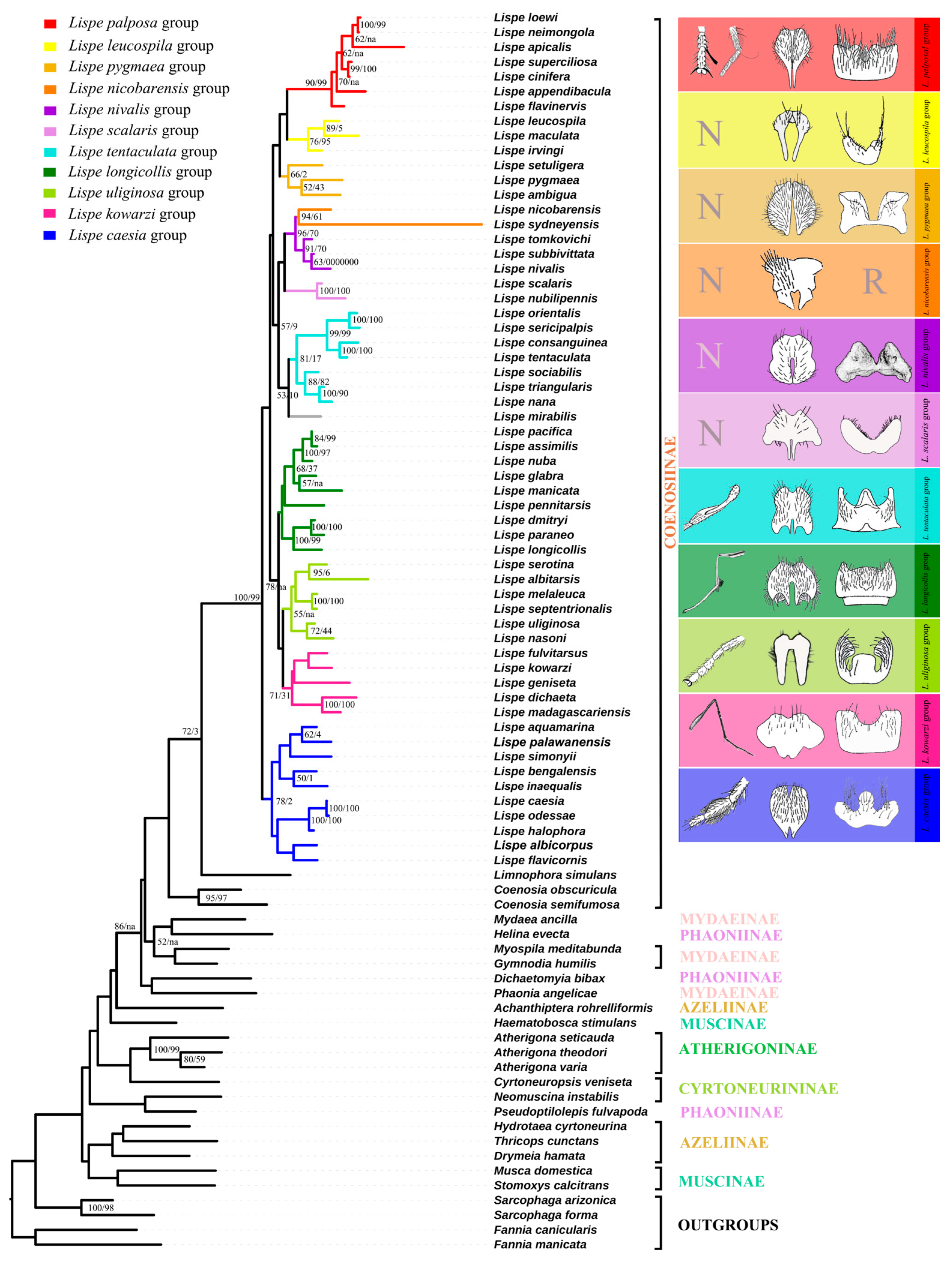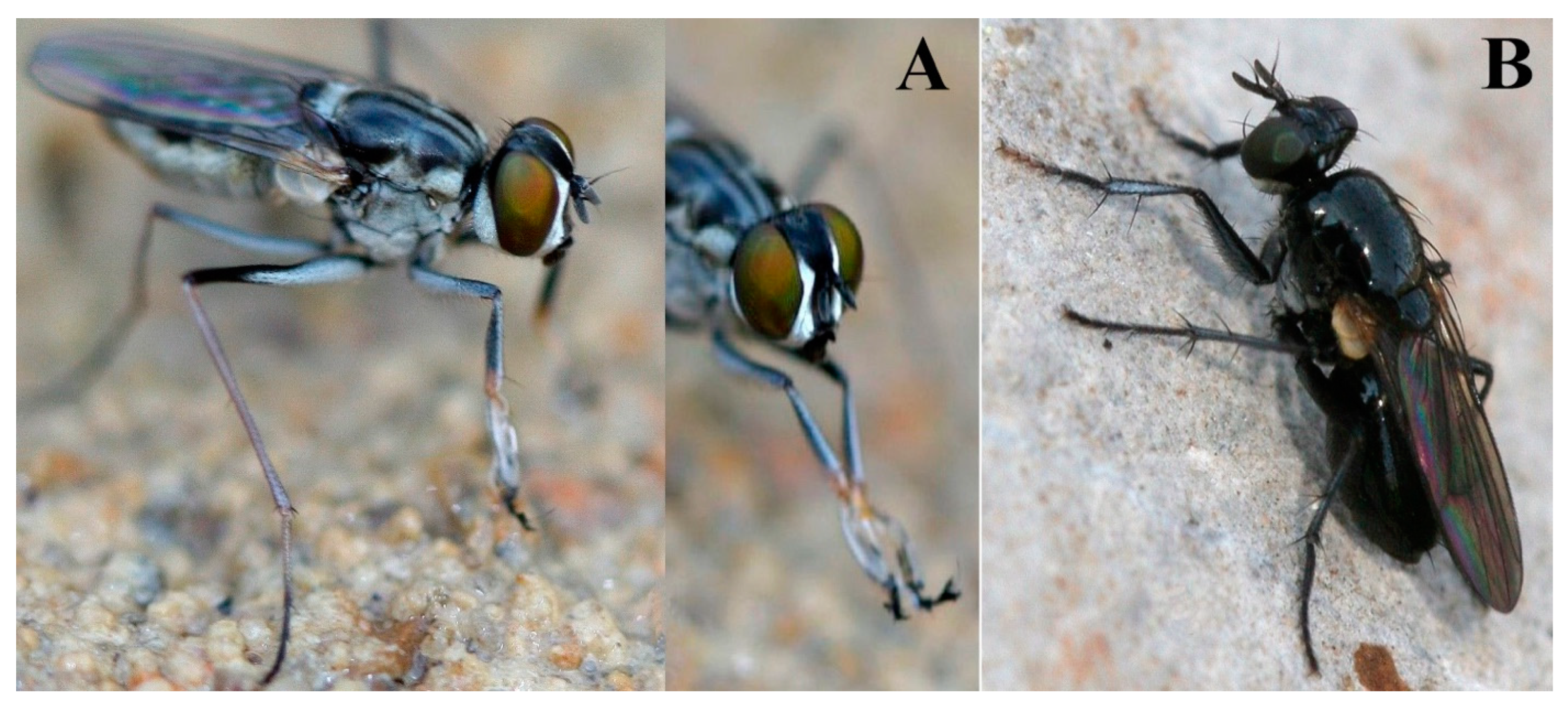Phylogenetic Analyses Support the Monophyly of the Genus Lispe Latreille (Diptera: Muscidae) with Insights into Intrageneric Relationships
Abstract
Simple Summary
Abstract
1. Introduction
2. Materials and Methods
2.1. Sampling and Molecular Protocols
2.2. Assembling, Aligning and Nucleotide Substitution Saturation Analysis
2.3. Phylogenetic Analyses
2.4. Specimen Deposition and Abbreviations
3. Results
3.1. Estimation of Substitution Saturation
3.2. Phylogenetic Analysis
4. Discussion
4.1. Generic Relationships within Muscidae
4.2. Intrageneric Relationships within Lispe
4.3. Evolution of Morphological Characteristics
4.4. Origin of Lispe
5. Conclusions
Supplementary Materials
Author Contributions
Funding
Institutional Review Board Statement
Informed Consent Statement
Data Availability Statement
Acknowledgments
Conflicts of Interest
References
- Carvalho, C.J.B.; Couri, M.S.; Pont, A.C.; Pamplona, D.; Lopes, S.M. A Catalogue of the Muscidae (Diptera) of the Neotropical Region. Zootaxa 2005, 860, 1–282. [Google Scholar] [CrossRef]
- Pape, T.; Blagoderov, V.; Mostovski, M.B. Order Diptera Linnaeus, 1758. In Animal Biodiversity: An Outline of Higher-Level Classification and Survey of Taxonomic Richness; Magnolia: Auckland, New Zealand, 2011. [Google Scholar]
- Kutty, S.N.; Pape, T.; Wiegmann, B.M.; Meier, R. Molecular Phylogeny of the Calyptratae (Diptera: Cyclorrhapha) with an Emphasis on the Superfamily Oestroidea and the Position of Mystacinobiidae and McAlpine’s Fly. Syst. Entomol. 2010, 35, 614–635. [Google Scholar] [CrossRef]
- Kutty, S.N.; Pont, A.C.; Meier, R.; Pape, T. Complete Tribal Sampling Reveals Basal Split in Muscidae (Diptera), Confirms Saprophagy as Ancestral Feeding Mode, and Reveals an Evolutionary Correlation between Instar Numbers and Carnivory. Mol. Phylogenet. Evol. 2014, 78, 349–364. [Google Scholar] [CrossRef] [PubMed]
- Kutty, S.N.; Meusemann, K.; Bayless, K.M.; Marinho, M.A.T.; Pont, A.C.; Zhou, X.; Misof, B.; Wiegmann, B.M.; Yeates, D.; Cerretti, P.; et al. Phylogenomic Analysis of Calyptratae: Resolving the Phylogenetic Relationships within a Major Radiation of Diptera. Cladistics 2019, 35, 605–622. [Google Scholar] [CrossRef]
- Kutty, S.N.; Pape, T.; Pont, A.; Wiegmann, B.M.; Meier, R. The Muscoidea (Diptera: Calyptratae) Are Paraphyletic: Evidence from Four Mitochondrial and Four Nuclear Genes. Mol. Phylogenet. Evol. 2008, 49, 639–652. [Google Scholar] [CrossRef]
- Ding, S.; Li, X.; Wang, N.; Cameron, S.L.; Mao, M.; Wang, Y.; Xi, Y.; Yang, D. The Phylogeny and Evolutionary Timescale of Muscoidea (Diptera: Brachycera: Calyptratae) Inferred from Mitochondrial Genomes. PLoS ONE 2015, 10, e0134170. [Google Scholar] [CrossRef]
- Haseyama, K.L.F.; Wiegmann, B.M.; Almeida, E.A.B.; de Carvalho, C.J.B. Say Goodbye to Tribes in the New House Fly Classification: A New Molecular Phylogenetic Analysis and an Updated Biogeographical Narrative for the Muscidae (Diptera). Mol. Phylogenet. Evol. 2015, 89, 1–12. [Google Scholar] [CrossRef]
- Vikhrev, N.E. Taxonomic Notes on Lispe (Diptera, Muscidae), Parts 10–12. Amurian Zool. J. 2015, VII, 228–247. [Google Scholar]
- Fogaça, J.M.; de Carvalho, C.J.B. Neotropical Lispe (Diptera: Muscidae): Notes, Redescriptions and Key to Species. J. Nat. Hist. 2018, 52, 2147–2184. [Google Scholar] [CrossRef]
- Snyder, F.M. A Review of Nearctic Lispe Latreille (Diptera, Muscidae). Am. Mus. Novit. 1954, 1675, 1–40. [Google Scholar]
- Steidle, J.L.M.; Dettner, K.; Huebner, G.; Koepf, A.; Reinhard, J. The Predaceous Fly Lispe Candicans (Diptera: Muscidae) Andits Chemically Protected Prey, the Rove Beetle Bledius Furcatus (Coleoptera: Staphylinidae). Entomol. Gen. 1995, 20, 11–19. [Google Scholar] [CrossRef]
- Frantsevich, L.; Gorb, S. Courtship Dances in the Flies of the Genus Lispe (Diptera: Muscidae): From the Flys Viewpoint. Arch. Insect Biochem. Physiol. 2006, 62, 26–42. [Google Scholar] [CrossRef] [PubMed]
- Pont, A.C.; Harutyunova, K.; Harutyunova, M.; Werner, D. The Hunter-Flies of Armenia. II. The Genus Lispe Latreille, 1796 (Insecta: Diptera: Muscidae). Zool. Middle East 2012, 55, 79–84. [Google Scholar] [CrossRef]
- Bradley, T.J. Saline-Water Insects: Ecology, Physiology and Evolution. In Aquatic Insects: Challenges to Populations; Lancaster, J., Briers, R., Eds.; CAB International: London, UK, 2008. [Google Scholar]
- White, T.E.; Vogel-Ghibely, N.; Butterworth, N.J. Flies Exploit Predictable Perspectives and Backgrounds to Enhance Iridescent Signal Salience and Mating Success. Am. Nat. 2020, 195, 733–742. [Google Scholar] [CrossRef]
- Butterworth, N.J.; Wallman, J.F. Flies Getting Filthy: The Precopulatory Mating Behaviours of Three Mud-Dwelling Species of Australian Lispe (Diptera: Muscidae). Ethology 2022, 128, 369–377. [Google Scholar] [CrossRef]
- Morse, J.C.; Yang, L.F.; Tian, L.X. Aquatic Insects of China Useful for Monitoring Water Quality; Hohai University Press: Nanjing, China, 1994. [Google Scholar]
- Aldrich, J.M. The North American Species of Lispa (Diptera; Anthomyidae). J. N. Y. Entomol. Soc. 1913, 21, 126–146. [Google Scholar]
- Snyder, F.M. New Genera and Species of Lispinae (Diptera, Muscidae). Am. Mus. Novit. 1949, 1403, 1–9. [Google Scholar]
- Hennig, W. Muscidae [Part, Lieferung 209 and 213]; Lindner, E., Ed.; Schweizerbart: Stuttgart, Germany, 1960. [Google Scholar]
- Vikhrev, N.E. Taxonomic Notes on Lispe (Diptera, Muscidae), Parts 1–9. Amur. Zool. J. 2014, VI, 147–170. [Google Scholar]
- Vikhrev, N.E.; Ge, Y.Q.; Zhang, D. On Taxonomy of the Lispe Caesia-Group (Diptera: Muscidae). Russ. Entomol. J. 2016, 25, 407–410. [Google Scholar] [CrossRef]
- Xue, W.Q.; Zhang, D. A Review of the Genus Lispe Latreille (Diptera: Muscidae) from China, with Descriptions of New Species. Orient. Insects 2005, 39, 117–139. [Google Scholar] [CrossRef]
- Zhang, D.; Ge, Y.Q.; Li, X.Y.; Liu, X.H.; Zhang, M.; Wang, R.R. Review of the Lispe Caesia-Group (Diptera: Muscidae) from Palaearctic and Adjacent Regions, with Redescriptions and One New Synonymy. Zootaxa 2016, 4098, 43–72. [Google Scholar] [CrossRef] [PubMed]
- Vikhrev, N. Review of the Palaearctic Members of the Lispe Tentaculata Species-Group (Diptera, Muscidae): Revised Key, Synonymy and Notes on Ecology. Zookeys 2011, 84, 59–70. [Google Scholar] [CrossRef] [PubMed]
- Vikhrev, N.E. Revision of the Lispe Longicollis-Group (Diptera, Muscidae). Zookeys 2012, 235, 23–39. [Google Scholar] [CrossRef] [PubMed]
- Ge, Y.; Gao, Y.; Yan, L.; Liu, X.; Zhang, D. Review of the Lispe Tentaculata-Group (Diptera: Muscidae) in China, with One New Synonym. Zoosystema 2016, 38, 339–352. [Google Scholar] [CrossRef]
- Vikhrev, N.E. Four New Species of Lispe Latreille, 1796 (Diptera, Muscidae) with Taxonomic Notes on Related Species. Russ. Entomol. J. 2012, 21, 423–433. [Google Scholar] [CrossRef]
- Vikhrev, N.E. Taxonomic Notes on Lispe (Diptera, Muscidae), Part 13. Amur. Zool. J. 2016, VIII, 171–185. [Google Scholar]
- Zhang, D.; Yan, L.; Zhang, M.; Chu, H.; Cao, J.; Li, K.; Hu, D.; Pape, T. Phylogenetic Inference of Calyptrates, with the First Mitogenomes for Gasterophilinae (Diptera: Oestridae) and Paramacronychiinae (Diptera: Sarcophagidae). Int. J. Biol. Sci. 2016, 12, 489–504. [Google Scholar] [CrossRef][Green Version]
- Folmer, O.; Black, M.; Hoeh, W.; Lutz, R.; Vrijenhoek, R. DNA Primers for Amplification of Mitochondrial Cytochrome c Oxidase Subunit I from Diverse Metazoan Invertebrates. Mol. Mar. Biol. Biotechnol. 1994, 3, 294–299. [Google Scholar]
- Moulton, J.K.; Wiegmann, B.M. Evolution and Phylogenetic Utility of CAD (Rudimentary) among Mesozoic-Aged Eremoneuran Diptera (Insecta). Mol. Phylogenet. Evol. 2004, 31, 363–378. [Google Scholar] [CrossRef]
- Lalitha, S. Primer Premier 5. Biotech. Softw. Internet. Rep. Comput. Softw. J. Scient. 2000, 1, 270–272. [Google Scholar] [CrossRef]
- Hall, T.; Biosciences, I.; Carlsbad, C. BioEdit: An Important Software for Molecular Biology. GERF Bull. Biosci. 2011, 2, 60–61. [Google Scholar]
- Katoh, K.; Standley, D.M. MAFFT Multiple Sequence Alignment Software Version 7: Improvements in Performance and Usability. Mol. Biol. Evol. 2013, 30, 772–780. [Google Scholar] [CrossRef] [PubMed]
- Kumar, S.; Stecher, G.; Li, M.; Knyaz, C.; Tamura, K. MEGA X: Molecular Evolutionary Genetics Analysis across Computing Platforms. Mol. Biol. Evol. 2018, 35, 1547–1549. [Google Scholar] [CrossRef] [PubMed]
- Xia, X.; Xie, Z.; Salemi, M.; Chen, L.; Wang, Y. An Index of Substitution Saturation and Its Application. Mol. Phylogenet. Evol. 2003, 26, 1–7. [Google Scholar] [CrossRef]
- Xia, X. DAMBE6: New Tools for Microbial Genomics, Phylogenetics, and Molecular Evolution. J. Hered. 2017, 108, 431–437. [Google Scholar] [CrossRef]
- Meier, R.; Shiyang, K.; Vaidya, G.; Ng, P.K.L. DNA Barcoding and Taxonomy in Diptera: A Tale of High Intraspecific Variability and Low Identification Success. Syst. Biol. 2006, 55, 715–728. [Google Scholar] [CrossRef]
- Nguyen, L.T.; Schmidt, H.A.; von Haeseler, A.; Minh, B.Q. IQ-TREE: A Fast and Effective Stochastic Algorithm for Estimating Maximum-Likelihood Phylogenies. Mol. Biol. Evol. 2015, 32, 268–274. [Google Scholar] [CrossRef]
- Trifinopoulos, J.; Nguyen, L.T.; von Haeseler, A.; Minh, B.Q. W-IQ-TREE: A Fast Online Phylogenetic Tool for Maximum Likelihood Analysis. Nucleic Acids Res. 2016, 44, W232–W235. [Google Scholar] [CrossRef]
- Drake, M. The Importance of Temporary Waters for Diptera (True-Flies). Freshw. Forum 2001, 17, 26–39. [Google Scholar]
- Malloch, J.R. Exotic Muscaridae (Diptera). VII. Ann. Mag. Nat. 1922, 9, 379–391. [Google Scholar] [CrossRef][Green Version]
- Malloch, J.R. Exotic Muscaridae (Diptera). V. Ann. Mag. Nat. 1992, 9, 271–280. [Google Scholar] [CrossRef][Green Version]
- van Emden, F.I. Keys to the Muscidae of the Ethiopian Region: Scatophaginae, Anthomyiinae, Lispinae, Fanniinae. Bull. Entomol. Res. 1941, 32, 251–275. [Google Scholar] [CrossRef]
- Pont, A.C. Family Muscidae. Catalog of the Diptera of the Australasian and Oceanian Regions; Evenhuis, N.L., Ed.; Bishop Museum Press: Honolulu, HI, USA, 1989; p. 804. [Google Scholar]



| Gene | Prime Sequence | Product Length | Source |
|---|---|---|---|
| COXIa-F | TACAATTTATCGCCTAAACTTCAGCC | ~850 bp | Folmer et al. 1994 [32] |
| COXIa-R | CCCGGTAAAATTAAAATATAAACTTC | ||
| COXIa-F | GGTCAACAAATCATAAAGATATTGG | ~750 bp | |
| COXIa-R | TATGTTTTACCTTGAGGACAAATATC | ||
| COIXb-F | CCACATTTATTTTGATTTTTTGG | ~850 bp | |
| COIXb-R | TCCAATGCACTAATCTGCCATATTA | ||
| COIXb-F | CCWGGATTYGGWATAATYTCT | ~700 bp | Zhang et al. 2016 [31] |
| COIXb-R | CTATGTTCAGCTGGYGGAGTA | ||
| CYTB-F | TAT GTT TTA CCT TGA GGA CAA ATA TC | ~800 bp | Kutty et al. 2014 [4] |
| CYTB-R | AAA TTC TAT CTT ATG TTT TCA AAA C | ||
| CAD-F | GGD GTN ACN GCN TGY TTY GAR CC | ~1000 bp | Moulton & Wiegmann 2003 [33] |
| CAD-R | TTN GGN AGY TGN CCN CCC AT | ||
| CAD-F | TGTGGGTGAGGTTATGGC | ~850 bp | Designed using Primer premier 5.0 [34] |
| CAD-R | CCTCGGAATGTTCCAGTT |
| Parameter/Locus | COXIa | COXIb | CYTB | CAD |
|---|---|---|---|---|
| Alignment length of A | 684 bp | 765 bp | 708 bp | 717 bp |
| Saturation’s test (Iss/Iss.c) | 0.389/0.721 | 0.390/0.729 | 0.368/0.723 | 0.382/0.724 |
| Substitution model in ML of A | GTR + F + I + G4 | GTR + F + I + G4 | GTR + F + I + G4 | TVMe + I + G4 |
| Substitution model in BI of A | GTR + I + G | GTR + I + G | GTR + I + G | SYM + I + G |
Publisher’s Note: MDPI stays neutral with regard to jurisdictional claims in published maps and institutional affiliations. |
© 2022 by the authors. Licensee MDPI, Basel, Switzerland. This article is an open access article distributed under the terms and conditions of the Creative Commons Attribution (CC BY) license (https://creativecommons.org/licenses/by/4.0/).
Share and Cite
Gao, Y.; Ge, Y.; Yan, L.; Vikhrev, N.E.; Wang, Q.; Butterworth, N.J.; Zhang, D. Phylogenetic Analyses Support the Monophyly of the Genus Lispe Latreille (Diptera: Muscidae) with Insights into Intrageneric Relationships. Insects 2022, 13, 1015. https://doi.org/10.3390/insects13111015
Gao Y, Ge Y, Yan L, Vikhrev NE, Wang Q, Butterworth NJ, Zhang D. Phylogenetic Analyses Support the Monophyly of the Genus Lispe Latreille (Diptera: Muscidae) with Insights into Intrageneric Relationships. Insects. 2022; 13(11):1015. https://doi.org/10.3390/insects13111015
Chicago/Turabian StyleGao, Yunyun, Yingqiang Ge, Liping Yan, Nikita E. Vikhrev, Qike Wang, Nathan J. Butterworth, and Dong Zhang. 2022. "Phylogenetic Analyses Support the Monophyly of the Genus Lispe Latreille (Diptera: Muscidae) with Insights into Intrageneric Relationships" Insects 13, no. 11: 1015. https://doi.org/10.3390/insects13111015
APA StyleGao, Y., Ge, Y., Yan, L., Vikhrev, N. E., Wang, Q., Butterworth, N. J., & Zhang, D. (2022). Phylogenetic Analyses Support the Monophyly of the Genus Lispe Latreille (Diptera: Muscidae) with Insights into Intrageneric Relationships. Insects, 13(11), 1015. https://doi.org/10.3390/insects13111015









